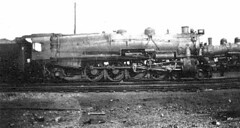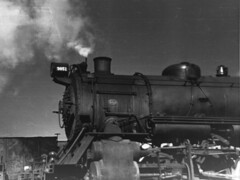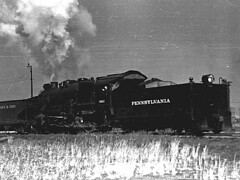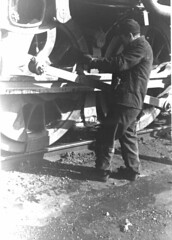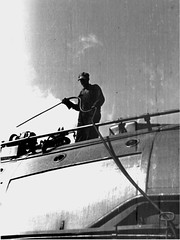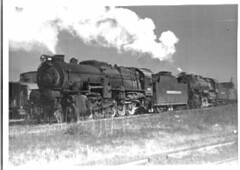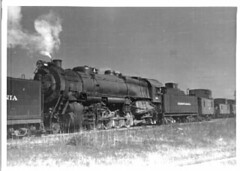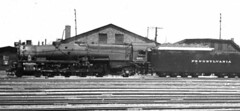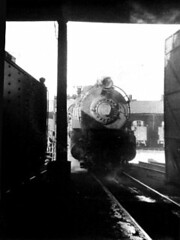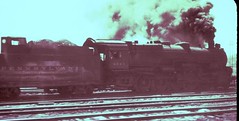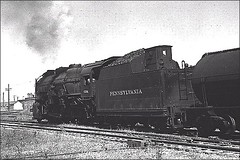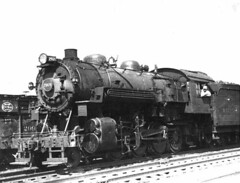Gerard M. Foley
Travel & Photography Collection
When I was ten my family returned to live in Philadelphia. Soon I met a boy named T. Martin Flatley, who was in the same grade in school as I, and who had a passionate interest in the locomotives of the Pennsylvania Railroad. A third young railfan was Bill Barnes, but Bill was somewhat separated from Martin and I because his main interest was in the engines of the Reading Company. For some reason none of us was very much interested in the Baltimore & Ohio, the other railroad that ran through Philadelphia. Martin and I were welcomed by railroad men in every engine yard and roundhouse in the area and thrown out of most of them by railroad detectives.
We "collected" engine numbers. This was slightly less trivial than it sounds because the Pennsy, as the railroad was nicknamed, before 1920 had the unusual practice of giving a new locomotive the number of one that had just been scrapped. Thus number 1 was a small Consolidation (2-8-0) type, class H6sb, while number 8 was a large Pacific (4-6-2), class K4s, and number 16 was a large Atlantic (4-4-2), class E6s. All the numbers in between were taken by other engines of other types; I only happen to remember these three. Each of us, in the common practice of pre-teens, had a "favorite" engine. Mine was number 6872, a class M1 Mountain (4-8-2) type. I haven't a picture of it, but here is a mate, number 6940.
The 201 M1's were so good that the PRR ordered 100 more Mountain types. They differed from the M1s in having feed water heaters. Also the cylinders and steam pipes were cast into the one piece cast steel frame, forming the bottom of the smoke box. The smoke box netting was also unusual. This scheme was tested on one of the two large Pacific 4-6-2 Class K5 locomotives built in 1929. The latter were never duplicated (PRR passenger locomotive needs were met until after WWII by electric locomotives operating on the Harrisburg-Washington-New York electrified lines). I don;t know how well the K5 ran, but the ten M1a's that were painted with gold striping for passenger service failed in that work. The boilers would not produce sufficient steam at high speeds, so when a heavy locomotive was needed for passenger service, the older M1's had to do the work.
In the summer of 1931 (or possibly 1930) I visited Missouri. I had an Agfa "Memo" camera, a 35mm camera which had a fixed focus lens and took "half frame" pictures. They were 18x24mm instead of the normal 24x36mm pictures of most 35mm cameras. I recently found a roll of negatives from that trip. The pictures are not very sharp! They were taken from the rear deck of the observation car of the Pennsylvania's crack New York - St.Louis train, called "The American".

The top two are Consolidation (2-8-0) types. The top left is probably class H8sb or H9s. The top right could be H8, H8a, H8b or H8c. The middle pair are class M1 Mountain (4-8-2) types. The first engine on the lower left is class I1s Decapod (2-10-0) type. I cannot identify the second of these two helper engines pushing a freight. The picture was probably taken in the Allegheny Mountains. The lower right picture is a class K4s Pacific (4-6-2) type, possibly the one that was pulling my train
As the years passed the time I spent hanging around railroad yards decreased a lot. Even so, I have found a few pictures which I took about 1938-41.
A puzzle. This picture and the one below seem to have been taken at the same time as the PRR pictures in this group. But the engine this man is working on has Baker valve gear, which the PRR never used except on the wartime J1 2-10-4's. I don't think I was taking locomotive pictures in engine yards at that time.

Fuzzy picture of a PRR Class C1 0-8-0 Heavy Switcher, the only eight-wheeled switcher built by the Pennsylvania in the 20th century.
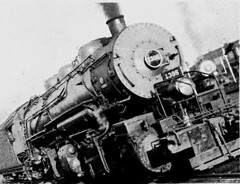
PRR CC1s 0-8-8-0 Mallet Compound Switcher/Helper. Pennsyvania Lines West (of Pittsburgh) was the only part of the railroad that used articulated mallet engines. Here is number 1395, a class CC1s 0-8-8-0 Mallet Compound Switcher/Helper. It looks as if there is another one in the background.
Still later, in 1945, I had a brief experience trying to advise some PRR men on the prevention of slipping of Q2 engines (4-4-6-4). These were the last steam locomotives built for the railroad, and were, by some measures, the most powerful reciprocating steam locomotives ever built by anyone. Unhappily I had no good ideas on how to solve the problem. These great locomotives had a very short service life. They were replaced in a few years by expensive, reliable, efficient, low maintenance diesel-electric locomotives.
These are scans from slides, mostly Ektachrome, which are completely undated.
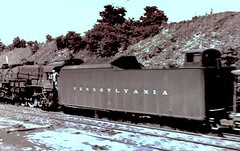
Obviously this engine almost got away from me. This huge tender was called "coast-to-coast". It wouldn't really make it, but it was big. The first big tenders on the PRR carried 21,000 gallons of water, and were bought with the M1a engines in 1930. Later 25,000 gallon tenders were built for use on K4s Pacific type passenger locomotives, but it was soon realized that carrying all that water around at 60-80 miles per hour was not such a good idea. Most of the latter group were used on I1s Decapod type freight locomotives, though I think some were attached to M1's, which had been built with 13,000 gallon tenders.
The I1s was first built by the Pennsylvania's Juniata Shops at Altoona Pa in 1916. Juniata built a total of 123 before 1923, when 475 were ordered from the Baldwin Locomotive Works. This was one of the largest orders for steam locomotives ever placed. The earlier engines received the PRR's typically random numbers, but this group was numbered consecutively from 4225 through 4699. They look slow and cumbersome, but I have seen them quite contentedly running faster than 40 mph.
Click for a great deal more information on the Pennsylvania Railroad

Reading Company Pacific 4-6-2 class G2sa in Reading Terminal, Philadelphia. (with Agfa Memo half frame camera)

Reading Company Pacific 4-6-2 class G2sa in Reading Terminal, Philadelphia. (with Agfa Memo half frame camera)
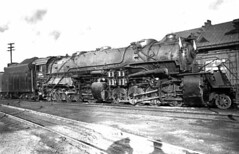
Norfolk and Western Articulated Mallet Compound 2-8-8-2. The Norfolk and Western liked big articulated engines, and stuck with Mallet compunding long after other railroads had switched to single explansion articulateds.

N&W Simple Articulated Engine number 1209. The N&W had some trains they wanted to go faster than a Mallet could, so they had single expansion articulated engines like number 1209, in addition to the Mallets. I'm not sure, but this may have had a 4-6-6-4 wheel arrangemenr. It was an N&W roundhouse foreman who started me on my fruitless search for the perfectly framed locomotive with this pose.
